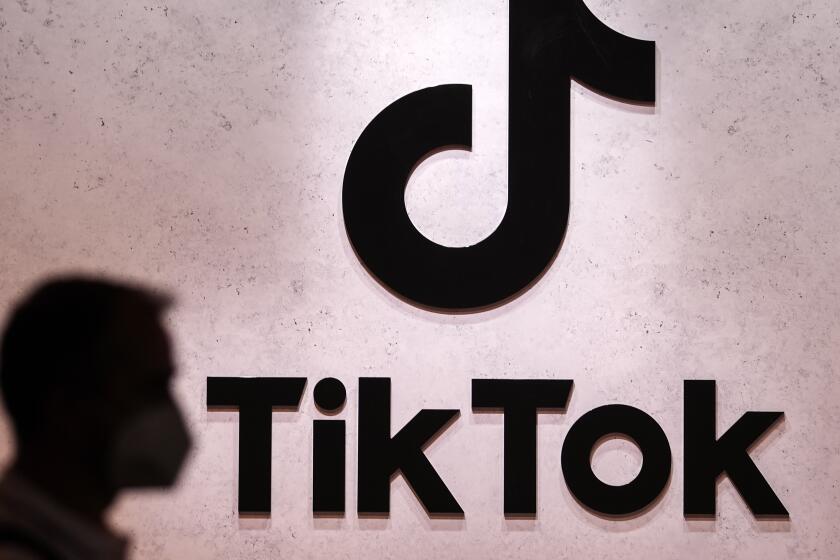THE CUTTING EDGE : Let the Video Games Begin : Technology: Race is on to see who will build America’s top-selling high-tech toys. For some firms, it’s ‘Mortal Kombat.’
Like a real-life version of a best-selling video game, the coming year promises to be a long and brutal battle for the companies that build America’s favorite high-tech toys.
It’s a struggle that will begin in earnest this week at the first Electronic Entertainment Exposition in Los Angeles, where five video game machine companies will show how they intend to win in the race to the next generation of game technology. For at least one of the warriors, it will be a veritable “Mortal Kombat.”
Inciting this is the relentless march of computer chip technology, which has advanced to the point where sophisticated 32-bit and 64-bit microprocessors and special graphics chips--long limited to powerful engineering workstations--can now be used in game machines. The same technologies, together with fast CD-ROM drives, have enabled personal computers to elbow their way into the video game world as well.
For hard-core “gamers,” the technology means 3-D graphics and video and top-quality sound that will truly immerse them in the video game’s fantasy world. It also means speed: lifelike Ninja warriors flying across the screen, and controls that allow the player to respond to the onslaught in real-time.
And for the industry, which saw the sales of new players fall by 40% last year, it hopefully means rejuvenated sales. But the big question is: sales for whom? Sega, Sony, Nintendo, and Atari all claim their advance machines boast technical superiority or better price performance or better games--or a combination of all three.
Many of the players--the corporate players, that is--have something to prove beyond even solidifying their positions in a game industry that now generates $6 billion a year in hardware and software revenue. For example, Sony, the muscular newcomer to the game business, is eager to prove that its embarrassingly expensive foray into Hollywood is producing a synergy with its sprawling consumer electronics operations.
“This is the biggest introduction for Sony since the CD,” says Chip Herman, marketing vice president for Sony Computer Entertainment. “There’s a lot of pressure on us to succeed.”
For Atari Corp. and 3DO Co., the stakes are even higher: Success with their latest machines is crucial to their very survival. And veteran combatants Sega Enterprises Ltd. and Nintendo Co. are determined to yield nothing to the newcomers--or to one another.
The first skirmish has already occurred in Japan. According to the market research firm Dataquest, Sony and Sega have each shipped about 300,000 units of their new machines, while 3DO, with its original Multiplayer, is third at 260,000.
But that is merely a warm-up: Now the battle is moving to American soil. At the Electronic Entertainment show this week, Sega will introduce the Saturn, the successor to its wildly popular Genesis machine. Sony will launch the Playstation. And 3DO will announce the technical specifications for its M2, which some gamers tout as the most impressive of the new video game machines--though better technology alone will not be enough to win.
Equally notable at the show is what will not be announced: Nintendo’s Ultra 64 machine. Video game aficionados had expected to get a first glimpse of the Ultra 64--designed with help from the computer animation wizards at Silicon Graphics and relying on old-style cartridges rather than CD-ROM discs--but Nintendo said last week it is holding back the product until next year.
The surprise announcement caused a flurry of rumors, including one that Nintendo was scrapping what it deemed an inadequate machine and would start from scratch on a new one. The real explanation seems to be that the software was weak, and that Nintendo decided it could afford to forgo the lucrative holiday selling season.
“The machine is done. We looked at the games available on the Ultra 64 versus the ones on the (older Nintendo) Super NES and we determined that there wasn’t a dramatic enough difference,” said George Harrison, marketing director for Nintendo of America. “We have to make sure that the games for the new machines make people take notice.”
Part of Nintendo’s calculus, analysts say, has to do with price. The new machines from Sony, Sega and 3DO will carry hefty price tags, ranging from $300 to $400. Parents are likely to think twice before spending that kind of money, particularly when Nintendo is promising to deliver the Ultra 64 at less than $250. Many market watchers believe that $100 to $125 is the price at which video game machines attract a mass market.
With prices high and games relatively few, analysts predict that the new machines won’t be flying off the shelves this Christmas. In fact, the outcome of this war probably won’t be clear for another year when all the machines are on the market, prices have dropped and there is a plethora of games for each.
Until then it will be a war of words in newspapers, magazines and, especially, on television. Sony will reportedly spend $40 million on advertising alone. Chiat Day, the advertising agency that dreamed up a famous 1984 commercial for Apple, will create TV spots for the Playstation.
Ultimately, a hit game will probably determine the victor. Sony’s Genesis machine had Sonic the Hedgehog. Nintendo had its Super Mario Brothers and, more recently, Donkey Kong Country, a game that has sold 7.5 million copies worldwide.
“Every successful machine has had its mega-hit,” said Patrick Ferrell, president of Infotainment World, a publisher of video game and other electronic entertainment magazines. “People were actually buying Sega’s Genesis to be able to play Sonic the Hedgehog.”
Multimedia PCs selling briskly into American homes offer even more potential competition for the video-game industry. Though dwarfed by the volume of a Sonic the Hedgehog, PC games such as Myst are growing in popularity. And a PC is versatile, which appeals to parents.
“The wild card is the PC,” said Fredric Paul, editor of Electronic Entertainment magazine. “Are parents going to spend $500 for a video game machine and games, essentially an electronic baby-sitter or are they going to spend $1,500 on a PC, something they can feel good about?
(BEGIN TEXT OF INFOBOX / INFOGRAPHIC)
Changing Market
The transition from older 16-bit technology to super-fast 32- and 64-bit machines promises to realign the video game industry. Worldwide 1994 market share:
16-Bit Players
Nintendo: 52.5%
Sega: 46.5%
Others: 1.0%
32-, 64-Bit Players
Sega: 37.5%
Panasonic/3DO: 30.9%
Sony: 22.5%
Others: 5.3%
Source: Dan Lavin, Dataquest
Battling Video Games
A new generation of video game technology will result in more realistic games. But experts expect only two or three of the new machines to survive the war in the marketplace.
Nintendo
Machine: Ultra 64
Price: less than $250
U.S. delivery date: April, 1996
Number of games at launch: at least six
The skinny: Thinks it can afford to skip upcoming Christmas retailing season. But can it?
*
Sega
Machine: Saturn
Price: between $350 and $450
U.S. delivery date: Sept. 2
Number of games at launch: 20
The skinny: Can it hold its new-found position as Nintendo’s equal?
*
Sony
Machine: Playstation
Price: between $300 and $450
U.S. delivery date: fall
Number of games at launch: 20
The skinny: New kid on the block has lots of technical and marketing firepower.
*
3DO
Machine: M2
Price: about $400 (estimated)
Delivery date: early next year (estimated)
Number of games at launch: 185 (M2 is compatible with its predecessor, the 3DO Multiplayer.)
The skinny: It’s do or die for this once-hot but now struggling upstart.
*
Atari
Machine: Jaguar
Price: between $149 and $159
Delivery date: available now
Number of games available: 24
The skinny: First with next-generation technology, but still gets no respect.



